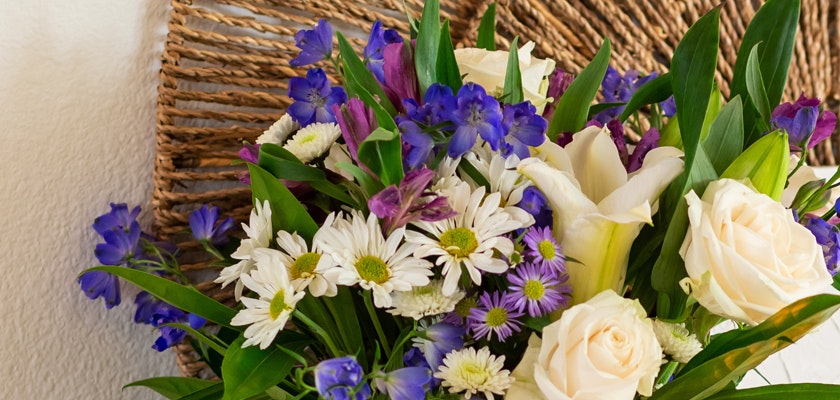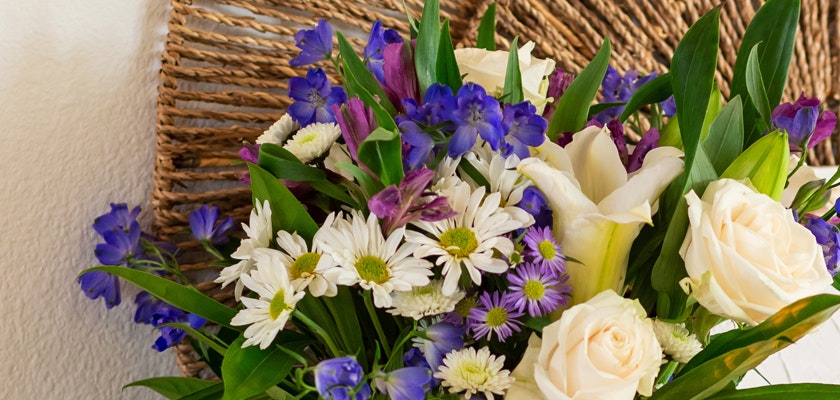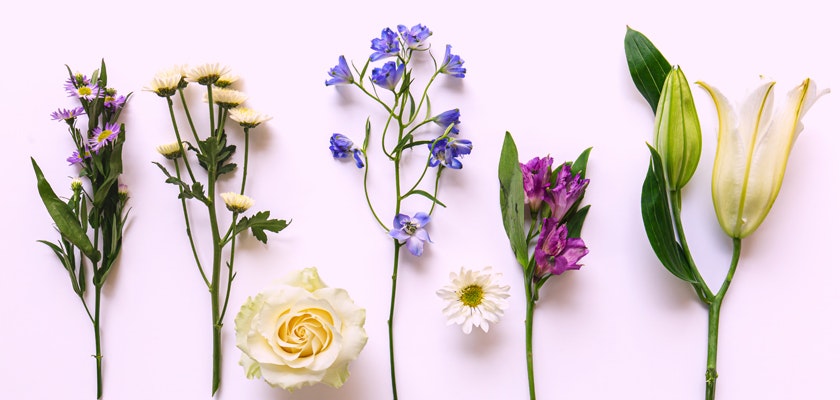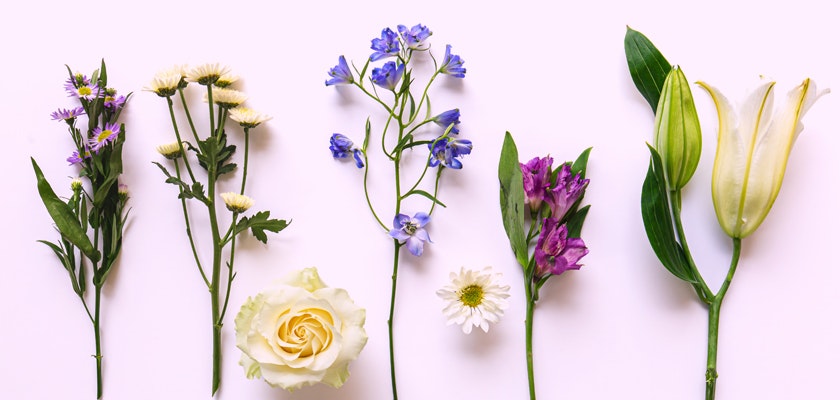September Birth Flowers: All About the Aster and Morning Glory
September is a month of transition, as summer’s heat gives way to the cool embrace of fall.
Discover the history, symbolism, and care tips for September birth flowers, aster and morning glory, with BloomsyBox
Celebrating birthdays during this time comes with the added charm of two beautiful birth flowers: the aster and morning glory. These flowers are rich in history, symbolism, and cultural significance, making them perfect for honoring those born in September.
Discover the history, symbolism, and care tips for September birth flowers, aster and morning glory, with BloomsyBox
Celebrating birthdays during this time comes with the added charm of two beautiful birth flowers: the aster and morning glory. These flowers are rich in history, symbolism, and cultural significance, making them perfect for honoring those born in September.
The aster, with its star-like blooms, brings elegance and grace. This flower has been admired since ancient times and continues to be a popular choice for gardens and floral arrangements. Its vibrant colors and delicate petals capture the essence of autumn, symbolizing love, patience, and wisdom. The aster's storied past and diverse appearances make it a fascinating subject for any flower enthusiast.
On the other hand, the morning glory offers a cheerful burst of color. Known for its rapid growth and trumpet-shaped flowers, the morning glory symbolizes affection and the beauty of dawn. It serves as a reminder to seize the day, as its blooms open in the morning and close by afternoon. This flower's ability to thrive in a variety of conditions and its cultural significance add to its appeal.
Both asters and morning glories are not only beautiful but also beneficial to their environments. They attract pollinators like bees, butterflies, and moths, contributing to the health of ecosystems. Their vibrant blooms can brighten any garden, making them favorites among gardeners and floral designers alike.
At BloomsyBox, we understand the unique qualities of these September birth flowers. Our curated bouquet online delivery featuring asters and morning glories capture their essence and convey their rich meanings. Whether you’re celebrating a birthday or simply enjoying the beauty of nature, our arrangements make a thoughtful and meaningful gift.
Explore the fascinating world of asters and morning glories in the sections below. Learn about their history, significance, care tips, and interesting facts that make these flowers truly remarkable.
Aster
The aster is a versatile and beloved flower, recognized for its daisy-like appearance and array of vibrant colors. Native to various parts of the world, including North America, Europe, and Asia, asters are hardy plants that can thrive in different climates and conditions. They are often found in meadows, prairies, and mountainous regions, adding a splash of color to the landscape.
Asters come in various shades, including white, pink, purple, lavender, blue, and occasionally yellow. This diversity in color makes them a popular choice for gardens and floral arrangements. Their blooms, which resemble small stars, have a unique charm that captures the essence of fall, bringing warmth and elegance to any setting.
Beyond their beauty, asters hold deep symbolic meanings. They represent love, patience, elegance, and wisdom. In some cultures, they are considered talismans of love and good luck, making them a thoughtful gift for special occasions. The aster’s ability to bloom late in the season also symbolizes resilience and endurance, qualities that resonate with many people.
History and Significance
The name “aster” comes from the Greek word for “star,” reflecting the flower’s star-shaped blossoms. Ancient Greeks believed that asters were created from stardust, linking them to the heavens and divine protection. According to mythology, the goddess Astraea transformed into a star and her tears became asters, symbolizing the flower's celestial origins.
In ancient times, asters were thought to ward off evil spirits. People would burn the leaves of asters to drive away negative energy and protect their homes. This practice highlights the flower's role as a guardian and protector, attributes that have carried through to modern interpretations of its symbolism.
Asters also played a significant role in Victorian floriography, the language of flowers. During this era, flowers were used to convey messages and emotions. Asters represented daintiness, love, and patience, making them a popular choice for romantic gestures and expressions of admiration. The flower's delicate appearance and rich meanings made it an essential part of Victorian floral arrangements.
Throughout history, asters have been associated with various gods and goddesses. In Greek mythology, they were linked to the gods of love and beauty, further emphasizing their romantic connotations. In Roman times, asters were placed on altars as offerings to the gods, symbolizing devotion and reverence.
Today, asters continue to be a symbol of love, wisdom, and elegance. They are often used in floral arrangements for weddings, anniversaries, and other special occasions. Their timeless beauty and deep meanings make them a cherished flower for expressing heartfelt emotions and celebrating life's significant moments.
To ensure your asters thrive, follow these care tips:
1. Watering: Asters prefer consistently moist soil. Water regularly, especially during dry spells, but avoid waterlogging. Ensure the soil has good drainage to prevent root rot.
2. Sun Exposure: Plant asters in full sunlight for at least six hours a day. Adequate sunlight promotes healthy growth and abundant blooms.
3. Soil Needs: Asters thrive in well-drained, loamy soil enriched with organic matter. Adding compost or well-rotted manure improves soil fertility and structure.
4. Mulching: Apply a layer of mulch around the base of the plants to retain moisture and regulate soil temperature. Mulch also helps suppress weeds, reducing competition for nutrients.
5. Fertilization: Use a balanced, water-soluble fertilizer every two weeks during the growing season. Over-fertilizing can lead to excessive foliage growth at the expense of flowers.
6. Pruning: Deadhead spent blooms regularly to encourage continuous flowering. Prune back the stems after the first frost to promote healthy regrowth in the spring.
7. Pest Control: Asters can be susceptible to pests like aphids and spider mites. Inspect plants regularly and treat infestations promptly with insecticidal soap or neem oil.
8. Disease Management: Ensure proper air circulation around plants to reduce the risk of fungal diseases like powdery mildew. Avoid overhead watering to prevent moisture from settling on the foliage.
9. Winter Care: In colder climates, cut back asters to the ground after the first hard frost. Apply a layer of mulch to protect the roots during winter. In warmer regions, asters may remain evergreen and require minimal winter care.
10. Propagation: Asters can be propagated by division or from seeds. Divide mature plants every two to three years in the spring to maintain plant health and vigor. Sow seeds indoors in late winter and transplant seedlings outdoors after the last frost.
Interesting Facts About Asters
1. Pollinator Attraction: Asters are a favorite among pollinators, including bees, butterflies, and hummingbirds. Their late-season blooms provide a crucial nectar source when many other flowers have faded, supporting biodiversity and ecosystem health.
2. Medicinal Uses: Historically, certain species of asters were used medicinally by Native American tribes. They utilized the plants to treat various ailments, such as headaches, colds, and skin irritations. While not commonly used in modern herbal medicine, these historical uses highlight the plant's versatility.
3. Cultural Significance: In Chinese culture, asters symbolize fidelity and are often used in wedding bouquets to represent a lasting commitment. The flower's association with love and loyalty transcends cultures, making it a universal symbol of enduring relationships.
4. Variety and Hybridization: There are over 600 species of asters, with numerous hybrids and cultivars developed for their unique colors and forms. This diversity allows gardeners to choose from a wide range of options to suit their preferences and garden designs.
5. Astronomical Connection: The aster's name, derived from the Greek word for "star," reflects its celestial connections. This link to the cosmos adds a layer of mystique and wonder to the flower's symbolism, making it a captivating subject for flower enthusiasts and astronomers alike.
The aster, with its star-like blooms, brings elegance and grace. This flower has been admired since ancient times and continues to be a popular choice for gardens and floral arrangements. Its vibrant colors and delicate petals capture the essence of autumn, symbolizing love, patience, and wisdom. The aster's storied past and diverse appearances make it a fascinating subject for any flower enthusiast.
On the other hand, the morning glory offers a cheerful burst of color. Known for its rapid growth and trumpet-shaped flowers, the morning glory symbolizes affection and the beauty of dawn. It serves as a reminder to seize the day, as its blooms open in the morning and close by afternoon. This flower's ability to thrive in a variety of conditions and its cultural significance add to its appeal.
Both asters and morning glories are not only beautiful but also beneficial to their environments. They attract pollinators like bees, butterflies, and moths, contributing to the health of ecosystems. Their vibrant blooms can brighten any garden, making them favorites among gardeners and floral designers alike.
At BloomsyBox, we understand the unique qualities of these September birth flowers. Our curated bouquet online delivery featuring asters and morning glories capture their essence and convey their rich meanings. Whether you’re celebrating a birthday or simply enjoying the beauty of nature, our arrangements make a thoughtful and meaningful gift.
Explore the fascinating world of asters and morning glories in the sections below. Learn about their history, significance, care tips, and interesting facts that make these flowers truly remarkable.
Aster
The aster is a versatile and beloved flower, recognized for its daisy-like appearance and array of vibrant colors. Native to various parts of the world, including North America, Europe, and Asia, asters are hardy plants that can thrive in different climates and conditions. They are often found in meadows, prairies, and mountainous regions, adding a splash of color to the landscape.
Asters come in various shades, including white, pink, purple, lavender, blue, and occasionally yellow. This diversity in color makes them a popular choice for gardens and floral arrangements. Their blooms, which resemble small stars, have a unique charm that captures the essence of fall, bringing warmth and elegance to any setting.
Beyond their beauty, asters hold deep symbolic meanings. They represent love, patience, elegance, and wisdom. In some cultures, they are considered talismans of love and good luck, making them a thoughtful gift for special occasions. The aster’s ability to bloom late in the season also symbolizes resilience and endurance, qualities that resonate with many people.
History and Significance
The name “aster” comes from the Greek word for “star,” reflecting the flower’s star-shaped blossoms. Ancient Greeks believed that asters were created from stardust, linking them to the heavens and divine protection. According to mythology, the goddess Astraea transformed into a star and her tears became asters, symbolizing the flower's celestial origins.
In ancient times, asters were thought to ward off evil spirits. People would burn the leaves of asters to drive away negative energy and protect their homes. This practice highlights the flower's role as a guardian and protector, attributes that have carried through to modern interpretations of its symbolism.
Asters also played a significant role in Victorian floriography, the language of flowers. During this era, flowers were used to convey messages and emotions. Asters represented daintiness, love, and patience, making them a popular choice for romantic gestures and expressions of admiration. The flower's delicate appearance and rich meanings made it an essential part of Victorian floral arrangements.
Throughout history, asters have been associated with various gods and goddesses. In Greek mythology, they were linked to the gods of love and beauty, further emphasizing their romantic connotations. In Roman times, asters were placed on altars as offerings to the gods, symbolizing devotion and reverence.
Today, asters continue to be a symbol of love, wisdom, and elegance. They are often used in floral arrangements for weddings, anniversaries, and other special occasions. Their timeless beauty and deep meanings make them a cherished flower for expressing heartfelt emotions and celebrating life's significant moments.
To ensure your asters thrive, follow these care tips:
1. Watering: Asters prefer consistently moist soil. Water regularly, especially during dry spells, but avoid waterlogging. Ensure the soil has good drainage to prevent root rot.
2. Sun Exposure: Plant asters in full sunlight for at least six hours a day. Adequate sunlight promotes healthy growth and abundant blooms.
3. Soil Needs: Asters thrive in well-drained, loamy soil enriched with organic matter. Adding compost or well-rotted manure improves soil fertility and structure.
4. Mulching: Apply a layer of mulch around the base of the plants to retain moisture and regulate soil temperature. Mulch also helps suppress weeds, reducing competition for nutrients.
5. Fertilization: Use a balanced, water-soluble fertilizer every two weeks during the growing season. Over-fertilizing can lead to excessive foliage growth at the expense of flowers.
6. Pruning: Deadhead spent blooms regularly to encourage continuous flowering. Prune back the stems after the first frost to promote healthy regrowth in the spring.
7. Pest Control: Asters can be susceptible to pests like aphids and spider mites. Inspect plants regularly and treat infestations promptly with insecticidal soap or neem oil.
8. Disease Management: Ensure proper air circulation around plants to reduce the risk of fungal diseases like powdery mildew. Avoid overhead watering to prevent moisture from settling on the foliage.
9. Winter Care: In colder climates, cut back asters to the ground after the first hard frost. Apply a layer of mulch to protect the roots during winter. In warmer regions, asters may remain evergreen and require minimal winter care.
10. Propagation: Asters can be propagated by division or from seeds. Divide mature plants every two to three years in the spring to maintain plant health and vigor. Sow seeds indoors in late winter and transplant seedlings outdoors after the last frost.
Interesting Facts About Asters
1. Pollinator Attraction: Asters are a favorite among pollinators, including bees, butterflies, and hummingbirds. Their late-season blooms provide a crucial nectar source when many other flowers have faded, supporting biodiversity and ecosystem health.
2. Medicinal Uses: Historically, certain species of asters were used medicinally by Native American tribes. They utilized the plants to treat various ailments, such as headaches, colds, and skin irritations. While not commonly used in modern herbal medicine, these historical uses highlight the plant's versatility.
3. Cultural Significance: In Chinese culture, asters symbolize fidelity and are often used in wedding bouquets to represent a lasting commitment. The flower's association with love and loyalty transcends cultures, making it a universal symbol of enduring relationships.
4. Variety and Hybridization: There are over 600 species of asters, with numerous hybrids and cultivars developed for their unique colors and forms. This diversity allows gardeners to choose from a wide range of options to suit their preferences and garden designs.
5. Astronomical Connection: The aster's name, derived from the Greek word for "star," reflects its celestial connections. This link to the cosmos adds a layer of mystique and wonder to the flower's symbolism, making it a captivating subject for flower enthusiasts and astronomers alike.
Morning Glory
Morning glories are known for their rapid growth and beautiful, trumpet-shaped flowers. Belonging to the genus Ipomoea, these climbing plants can quickly cover trellises, fences, and other structures, providing a stunning display of vibrant blooms. Their ability to grow in diverse conditions makes them a popular choice for gardeners looking to add a splash of color to their landscapes.
The flowers of morning glories come in various shades, including blue, purple, pink, red, white, and sometimes yellow. Each bloom opens in the morning and closes by afternoon, a characteristic that inspired their name. This daily blooming cycle adds a dynamic element to gardens, as new flowers appear each day, bringing fresh beauty to the space.
Morning glories are more than just visually appealing; they also hold deep symbolic meanings. These flowers represent affection, love, and the transient nature of life. Their brief blooming period serves as a reminder to seize the moment and appreciate the beauty of the present.
History and Significance
Morning glories have been cultivated for centuries and hold significant cultural and symbolic meanings in various societies. In Japan, the morning glory, known as "Asagao," is a beloved flower that symbolizes the fleeting beauty of summer. It is celebrated in festivals and art, reflecting its importance in Japanese culture.
In China, morning glories represent happiness, peace, and harmony. They are often associated with positive energy and good fortune. The flower's ability to thrive in different conditions and its vibrant colors make it a symbol of resilience and optimism.
Native American tribes also held morning glories in high regard. They viewed the flowers as symbols of spirituality and renewal. The morning glory's daily blooming cycle was seen as a metaphor for the cycle of life, death, and rebirth, reinforcing the flower's spiritual significance.
Morning glories have practical uses as well. Some species produce seeds that contain compounds with medicinal properties. In traditional medicine, morning glory seeds were used as laxatives and to treat various ailments. However, it's important to note that some species of morning glory seeds can be toxic if ingested in large quantities, so they should be used with caution and under proper guidance.
In literature and art, morning glories have often been used to symbolize love and devotion. Their tendency to open at dawn and close by afternoon is seen as a representation of the fleeting nature of love and the importance of cherishing every moment. This poetic quality has made them a popular subject for writers and artists throughout history.
Morning glories are also known for their rapid growth and vigorous climbing ability. This makes them ideal for creating vertical interest in gardens and landscapes. They can quickly cover trellises, arbors, and fences, providing not only beauty but also privacy and shade. The ease of growing morning glories and their stunning blooms make them a favorite among gardeners of all skill levels.
To care for morning glories, consider these tips:
1. Watering: Morning glories require consistent moisture but should not be waterlogged. Water the plants deeply once a week, ensuring the soil is moist but well-drained. During dry spells, increase watering frequency to prevent the soil from drying out completely.
2. Sun Exposure: Morning glories thrive in full sunlight, requiring at least six hours of direct sunlight daily. Adequate sunlight ensures robust growth and vibrant blooms. Plant them in a sunny location to maximize their flowering potential.
3. Soil Needs: These flowers prefer well-drained soil with moderate fertility. Sandy or loamy soils are ideal, as they allow for proper drainage while retaining enough moisture for the plants. Adding organic matter can enhance soil fertility and structure.
4. Support Structures: Morning glories are vigorous climbers and need support to grow upward. Provide a trellis, fence, or arbor for the vines to climb on. This support not only aids in their growth but also enhances their visual appeal in the garden.
5. Seed Sowing: Sow morning glory seeds directly in the ground after the danger of frost has passed. Soak the seeds overnight to soften their hard outer coating, which aids in germination. Plant them about 1/4 inch deep and space them 6-12 inches apart.
6. Pruning: Prune morning glories regularly to remove spent flowers and control excessive growth. Deadheading encourages continuous blooming and prevents self-seeding, which can lead to an overabundance of plants in the following season.
7. Fertilization: Morning glories do not require heavy fertilization. A light application of balanced, all-purpose fertilizer during the growing season is sufficient. Over-fertilizing can result in lush foliage at the expense of flowers.
8. Pest Control: While generally resistant to pests, morning glories can occasionally be affected by aphids and spider mites. Inspect plants regularly and treat infestations with insecticidal soap or neem oil. Keeping the garden clean and free of debris helps prevent pest problems.
9. Disease Management: Ensure proper air circulation around plants to reduce the risk of fungal diseases like powdery mildew. Avoid overhead watering to prevent moisture from settling on the foliage, which can lead to disease development.
10. Winter Care: In colder climates, morning glories are typically grown as annuals. Collect seeds from mature pods at the end of the growing season for planting next year. In warmer regions, they may survive as perennials and require minimal winter care.
Interesting Facts About Morning Glories:
1. Historical Use in Traditional Medicine: Certain species of morning glories, such as Ipomoea purga, were historically used in traditional medicine for their laxative properties. The seeds contain compounds that can induce bowel movements, though this use requires caution due to potential toxicity.
2. Symbolism in Different Cultures: Morning glories hold diverse symbolic meanings across cultures. In Victorian floriography, they represented love in vain or unrequited love, highlighting the flower's association with fleeting beauty and ephemeral moments.
3. Attracting Pollinators: Morning glories produce nectar that attracts a variety of pollinators, including bees, butterflies, and hummingbirds. This makes them valuable additions to pollinator gardens, supporting local ecosystems and biodiversity.
4. Rapid Growth Rate: Morning glories are known for their fast growth, with some varieties capable of growing several feet in one season. This rapid growth makes them excellent choices for quickly covering unsightly structures or creating green screens.
5. Variety of Species: There are over 1,000 species of morning glories, each with unique characteristics and adaptations. This vast diversity allows gardeners to choose from a wide range of colors, sizes, and growth habits to suit their specific needs and preferences.
Morning Glory
Morning glories are known for their rapid growth and beautiful, trumpet-shaped flowers. Belonging to the genus Ipomoea, these climbing plants can quickly cover trellises, fences, and other structures, providing a stunning display of vibrant blooms. Their ability to grow in diverse conditions makes them a popular choice for gardeners looking to add a splash of color to their landscapes.
The flowers of morning glories come in various shades, including blue, purple, pink, red, white, and sometimes yellow. Each bloom opens in the morning and closes by afternoon, a characteristic that inspired their name. This daily blooming cycle adds a dynamic element to gardens, as new flowers appear each day, bringing fresh beauty to the space.
Morning glories are more than just visually appealing; they also hold deep symbolic meanings. These flowers represent affection, love, and the transient nature of life. Their brief blooming period serves as a reminder to seize the moment and appreciate the beauty of the present.
History and Significance
Morning glories have been cultivated for centuries and hold significant cultural and symbolic meanings in various societies. In Japan, the morning glory, known as "Asagao," is a beloved flower that symbolizes the fleeting beauty of summer. It is celebrated in festivals and art, reflecting its importance in Japanese culture.
In China, morning glories represent happiness, peace, and harmony. They are often associated with positive energy and good fortune. The flower's ability to thrive in different conditions and its vibrant colors make it a symbol of resilience and optimism.
Native American tribes also held morning glories in high regard. They viewed the flowers as symbols of spirituality and renewal. The morning glory's daily blooming cycle was seen as a metaphor for the cycle of life, death, and rebirth, reinforcing the flower's spiritual significance.
Morning glories have practical uses as well. Some species produce seeds that contain compounds with medicinal properties. In traditional medicine, morning glory seeds were used as laxatives and to treat various ailments. However, it's important to note that some species of morning glory seeds can be toxic if ingested in large quantities, so they should be used with caution and under proper guidance.
In literature and art, morning glories have often been used to symbolize love and devotion. Their tendency to open at dawn and close by afternoon is seen as a representation of the fleeting nature of love and the importance of cherishing every moment. This poetic quality has made them a popular subject for writers and artists throughout history.
Morning glories are also known for their rapid growth and vigorous climbing ability. This makes them ideal for creating vertical interest in gardens and landscapes. They can quickly cover trellises, arbors, and fences, providing not only beauty but also privacy and shade. The ease of growing morning glories and their stunning blooms make them a favorite among gardeners of all skill levels.
To care for morning glories, consider these tips:
1. Watering: Morning glories require consistent moisture but should not be waterlogged. Water the plants deeply once a week, ensuring the soil is moist but well-drained. During dry spells, increase watering frequency to prevent the soil from drying out completely.
2. Sun Exposure: Morning glories thrive in full sunlight, requiring at least six hours of direct sunlight daily. Adequate sunlight ensures robust growth and vibrant blooms. Plant them in a sunny location to maximize their flowering potential.
3. Soil Needs: These flowers prefer well-drained soil with moderate fertility. Sandy or loamy soils are ideal, as they allow for proper drainage while retaining enough moisture for the plants. Adding organic matter can enhance soil fertility and structure.
4. Support Structures: Morning glories are vigorous climbers and need support to grow upward. Provide a trellis, fence, or arbor for the vines to climb on. This support not only aids in their growth but also enhances their visual appeal in the garden.
5. Seed Sowing: Sow morning glory seeds directly in the ground after the danger of frost has passed. Soak the seeds overnight to soften their hard outer coating, which aids in germination. Plant them about 1/4 inch deep and space them 6-12 inches apart.
6. Pruning: Prune morning glories regularly to remove spent flowers and control excessive growth. Deadheading encourages continuous blooming and prevents self-seeding, which can lead to an overabundance of plants in the following season.
7. Fertilization: Morning glories do not require heavy fertilization. A light application of balanced, all-purpose fertilizer during the growing season is sufficient. Over-fertilizing can result in lush foliage at the expense of flowers.
8. Pest Control: While generally resistant to pests, morning glories can occasionally be affected by aphids and spider mites. Inspect plants regularly and treat infestations with insecticidal soap or neem oil. Keeping the garden clean and free of debris helps prevent pest problems.
9. Disease Management: Ensure proper air circulation around plants to reduce the risk of fungal diseases like powdery mildew. Avoid overhead watering to prevent moisture from settling on the foliage, which can lead to disease development.
10. Winter Care: In colder climates, morning glories are typically grown as annuals. Collect seeds from mature pods at the end of the growing season for planting next year. In warmer regions, they may survive as perennials and require minimal winter care.
Interesting Facts About Morning Glories:
1. Historical Use in Traditional Medicine: Certain species of morning glories, such as Ipomoea purga, were historically used in traditional medicine for their laxative properties. The seeds contain compounds that can induce bowel movements, though this use requires caution due to potential toxicity.
2. Symbolism in Different Cultures: Morning glories hold diverse symbolic meanings across cultures. In Victorian floriography, they represented love in vain or unrequited love, highlighting the flower's association with fleeting beauty and ephemeral moments.
3. Attracting Pollinators: Morning glories produce nectar that attracts a variety of pollinators, including bees, butterflies, and hummingbirds. This makes them valuable additions to pollinator gardens, supporting local ecosystems and biodiversity.
4. Rapid Growth Rate: Morning glories are known for their fast growth, with some varieties capable of growing several feet in one season. This rapid growth makes them excellent choices for quickly covering unsightly structures or creating green screens.
5. Variety of Species: There are over 1,000 species of morning glories, each with unique characteristics and adaptations. This vast diversity allows gardeners to choose from a wide range of colors, sizes, and growth habits to suit their specific needs and preferences.
By understanding the rich history, significance, and care requirements of asters and morning glories, you can appreciate these September birth flowers even more. At BloomsyBox, we celebrate their unique qualities and offer floral arrangements that honor their beauty and meaning. Whether you're marking a special occasion or simply enjoying their splendor, asters and morning glories are sure to leave a lasting impression.
By understanding the rich history, significance, and care requirements of asters and morning glories, you can appreciate these September birth flowers even more. At BloomsyBox, we celebrate their unique qualities and offer floral arrangements that honor their beauty and meaning. Whether you're marking a special occasion or simply enjoying their splendor, asters and morning glories are sure to leave a lasting impression.




